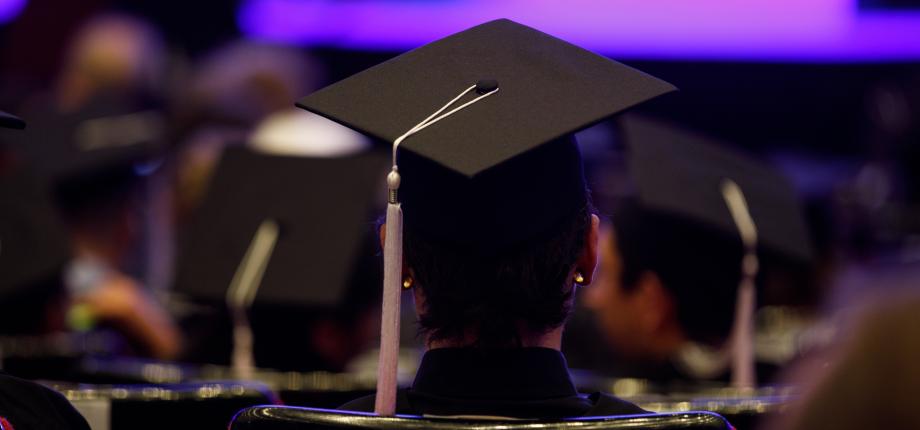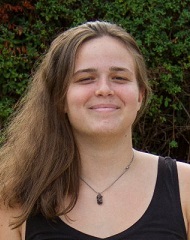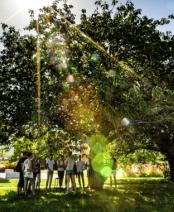Institut Polytechnique de Paris awards its 2024 thesis prizes

Seven doctoral students distinguished themselves in this 2024 edition. Six of them were rewarded in the best research department thesis category, receiving a prize of €3,000. The Grand Thesis Award (€5,000) went to Nolwen Mahieu for her work entitled “Synthesis, redox chemistry and study of the electronic structure of lanthanide complexes with aromatic ligands of different sizes”.

Nolwenn Mahieu, Insitut Polytechnique de Paris Best Thesis Award 2024
Thesis title: Synthesis, redox chemistry and electronic structure studies of lanthanide complexes with aromatic ligands of different sizes
Lanthanum, neodymium, samarium, thulium... These elements are less well known than other metals such as iron or cobalt. This family of “lanthanides” was at the heart of Nolwenn Mahieu's thesis.
Lanthanum, neodymium, samarium, thulium... These elements are less well known than other metals such as iron or cobalt. The lanthanide series, in fact, was the focus of Nolwenn Mahieu's thesis at the Molecular Chemistry Laboratory (LCM). In the periodic table, the lanthanides occupy the first of the two lines that appear at the very bottom, below the main block. "For a long time, these elements were thought to be similar to each other. But the more we study them, the more we notice that they each have specific properties", explains the researcher.
In her thesis, she focused on two properties in particular: reactivity and magnetism. These studies required a great deal of chemical synthesis. First, a lanthanide, such as thulium, is taken and one or more organic molecules (called ligands) are attached to it. The result is an assembly (a complex) whose specific characteristics can be studied. "I have studied the reactivity of complexes formed with ligands composed of rings of carbon atoms, in particular rings of 5, 8 or 9 atoms", explains the chemist. By playing with the number of electrons in these thulium complexes (the degree of oxidation), Nolwenn Mahieu contributed to showing that this favored the reactivity of small molecules, such as carbon dioxide, which are not usually very reactive. "The challenge was to find a good trade-off between the stability of the complex and its reactivity".
As for magnetism, the young researcher has synthesized complexes based on dysprosium, another lanthanide: coordination with the ligand enables the molecule to behave like a magnet on a molecular scale. Ultimately, these molecular nanomagnets could be used for data storage or quantum computing. "But more than the potential applications, it's the better fundamental understanding of molecules that I'm really interested in. Part of my thesis also involved extending these studies to other elements in the lanthanide series: there are still many unknowns," asserts the chemist, who is now pursuing her explorations of the family of elements just below the lanthanides in the periodic table, the actinides, at Lawrence-Berkeley National Laboratory (USA).
*LCM: a joint research unit CNRS, École Polytechnique, Institut Polytechnique de Paris, 91120 Palaiseau, France

Meyer Scetbon, Department of Mathematics Best Thesis Award 2024
Thesis title: Advances in Optimal Transport: Low Rank Structures and Applications to Machine Learning
Meyer Scetbon's work applies to artificial intelligence and machine learning. It overcomes the physical limitations of current machines and optimizes large-scale data processing.
Let's imagine a set of known data that a generative AI must recreate. Each set is represented by a point cloud in which each point is a piece of information. The aim is to reduce the differences (the distance) between the cloud generated by the AI and the original. To achieve this, the scientists compare the clouds with each other and try to match the most similar points from one set to the next. “In theory, optimal transport (OT), which I became interested in during my thesis at Center for Research in Economics and Statistics (CREST*), is one of the most effective methods for achieving this,” points out Meyer Scetbon.
Invented by Gaspard Monge in the 18th century, TO enabled the mathematician to determine how to fill holes at the lowest cost using earth cuttings and fillings. He considered transport constraints, the size of the holes and the quantity of soil available before distributing it. By analogy, the TO locates and very finely evaluates the differences in points between our data clouds (holes on one side, quantity of earth on the other, distance to be covered). It then looks for the optimal strategy that will enable the AI to associate the points of each set and model the cloud it seeks to reproduce as best and as frugally as possible (ventilating the earth in the holes at the lowest cost).
However, optimal transport answers an equation whose solution is super-cubic in relation to the number of points. In other words, a cloud of 1,000 data points requires billions of operations to process efficiently. Nevertheless, the memory and computing power of today's machines don't allow for this. “In 2013, my thesis supervisor had developed an algorithm that significantly reduced the number of operations. Ten years later, I have arrived at a new TO resolution scheme, known as low-rank, which is less resource-hungry, and therefore applicable to large-scale data processing”.
Optimal transport will thus contribute to the robustness of algorithms, helping AIs to thwart “attacks by contradictory examples”**. In economics, it will contribute to the fair sharing of goods or objects. In data science, it will optimize the simultaneous use of processors with different specificities. “Biologists will also be able to use this tool in genomics to process huge quantities of data. New perspectives are opening up”, concludes Meyer Scetbon.
* CREST: a joint research unit CNRS, École Polytechnique, GENES, ENSAE Paris, Institut Polytechnique de Paris, 91120 Palaiseau, France
** these attacks aim to subject corrupted data to generative AI in the production phase, for example by assigning the label crocodile to an image of a rabbit, thereby altering its behavior.

Nickson Mwamsojo, Department of Information, Communication and Electronic Best Thesis Award 2024
Thesis title: Neuromorphic photonic systems for information processing
Artificial intelligence consumes energy and material resources. Nickson Mwamsojo has developed an algorithm to make it more frugal. The principle: optimize the operating variables of certain neural networks.
“My algorithm applies to photonic neuromorphic networks and reservoir computing”, says Nickson Mwamsojo whose doctorate took place in the SAMOVAR Lab*. Behind these almost science-fiction terms lies a concept that curbs the gargantuan energy and material requirements of artificial intelligence.
Neural networks are usually computer programs whose aim is to mimic the human brain in decision-making. Going against the grain of dematerialization, Nickson Mwamsojo uses physical networks. “The idea is to reproduce in an analog way the communication between interconnected neurons in a brain - hence the term neuro-morphic - while reducing energy expenditure”, explains the young researcher. He chooses light to operate them (this is the photonics part of the project) and sends a laser beam through a fiber-optic circuit. Not only is the device more energy-efficient, but it can also process several pieces of information in parallel if beams of different wavelengths are used. Reservoir computing, an architecture that simplifies the learning of neural networks, also offers significant energy savings.
However, this shift to the “physical” brings with it other constraints to which the scientist's algorithm responds. “In virtual neural networks, the hyperparameters (voltage, laser intensity, etc.) that affect their operation are programmed and optimized. This is impossible in a physical system. The algorithm is therefore there to continuously monitor the components and adjust the hyperparameters so that the system always works at its best and remains stable over time”.
Initial trials carried out at Broca Hospital (Paris) as part of the early handwriting detection of Alzheimer's disease have been conclusive. “This system is proving to be as diagnostically effective as conventional devices, with one major advantage: it consumes far less energy”.
*SAMOVAR: a research lab Télécom SudParis, Institut Polytechnique de Paris, 91120 Palaiseau, France

Rodolphe Grivet, Department of Mechanics and Energetics Best Thesis Award 2024
Thesis title: Contact line movements and solidification
Physics has already explored the flow of a drop of water on the surface of a solid. But what happens when it solidifies on contact with cold? This is an important subject, of great interest to industry and environmentalists alike.
To understand the studies that punctuated Rodolphe Grivet's three-year thesis at Hydrodynamics Laboratory (LadHyX*) and the Institut Jean le Rond d'Alembert **, we need to zoom in on the line of contact between a drop of water and the surface on which it moves. Where air, solid and liquid meet.
Equipped with a camera that films at millisecond intervals and under polarized light, Rodolphe Grivet first observed the movement of this line when a drop spreads out on a cold surface. “Small ice crystals form inside the drop, grow, catch up with the contact line and stop it. They appear because the water close to the cold surface is metastable (editor's note: it is liquid but can rapidly evolve towards a solid state which is stable) and tends to solidify”, explains the scientist. Secondly, the young researcher analyzed the fragmentation (splash) of a drop impacting very cold surfaces. He showed that, at -60°C and above, these surfaces appeared superhydrophobic. At these temperatures, solidification at the contact surface appears to hinder water spreading. Finally, Rodolphe Grivet studied the wettability of ice, a property characterized by the angle formed at the line of contact between the solid surface and the liquid surface. The more a surface is wetted, the more the drop spreads, and the closer the angle is to 0°, reflecting the affinity of the liquid with the solid. However, when a drop of water encounters ice, the drop spontaneously shrinks, suggesting that this angle is non-zero. Rodolphe Grivet has verified this hypothesis with an experiment that measures the angle in a well-controlled situation. “It's counter-intuitive,” he says,” but liquid water doesn't like solid water”.
This work is of interest to industry and the environmental sector. Understanding the flow of molten metal, for example, is crucial in the field of additive manufacturing. Aeronautics, for its part, is impacted by the solidification of water on aircraft fairings and flight instrumentation. Finally, Rodolphe Grivet's work could shed light on the flows involved in stalactites and icefalls.
*LadHyX: a joint research unit of CNRS, École Polytechnique, Institut Polytechnique de Paris, 91120 Palaiseau, France.
** Institut Jean Le Rond d’Alembert : a joint research unit of Sorbonne Universities, CNRS, Paris, France.

Jaafar Chakrani, Department of Physics Best Thesis Award 2024
Thesis title: Towards a complete understanding of neutrino-nucleus interactions with the upgrade of the T2K near detector
During his thesis, Jaafar Chakrani took part in the major international T2K collaboration, whose aim is to understand why the universe is predominantly formed of matter, even though it was produced in the same proportion as antimatter during the big bang.
Why is the Universe overwhelmingly made up of matter and not antimatter? Yet everything suggests that antimatter and matter particles, which are in some ways each other's twins, were produced in the same proportion at the time of the Big Bang. The T2K experiment in Japan is a major international collaboration that is attempting to provide some answers to this big question. Jaafar Chakrani completed his thesis at the Leprince-Ringuet laboratory for particle physics and astrophysics (LLR*) as part of this collaboration.
The principle behind T2K: a beam of neutrinos (or antineutrinos, their antimatter twins) created at a particle gas pedal on Japan's east coast, travels over 300 km to the country's west coast. During this journey, these particles “oscillate”, i.e. they transform from one type of neutrino (or antineutrino) to another. The aim is to measure any subtle differences in the behavior of neutrinos and antineutrinos, which could partly explain the asymmetry between matter and antimatter in the Universe. T2K began in 2010 and has already yielded clues in this direction. The experiment has just undergone a major update, to which Jaafar Chakrani contributed.
In particular, the detector close to the neutrino source has been improved. “I worked not only on the hardware side, the detector's electronic acquisition chain, but also on the analysis and theoretical modeling of measurement uncertainties”. Indeed, the detector measures the energy of neutrinos at the start of their journey, a quantity that it is essential to know with the best possible precision. This is a challenge, as neutrinos are extremely difficult to detect. To do this, researchers indirectly measure the particles produced when a neutrino collides with the nucleus of an atom in the detector. Jaafar Chakrani has therefore considered many of the nuclear physics effects at work in his modeling, which will now be useful for analyzing the new data taken by T2K up to 2027. Today, he is continuing his research in the field: he has joined another international neutrino collaboration, DUNE, in the USA, which is designing an experiment similar to T2K.
*LLR : a joint research unit CNRS, École Polytechnique, Institut Polytechnique de Paris, 91120 Palaiseau, France

Maxime Bombar, Department of Computer Science, Data and AI Best Thesis Award 2024
Thesis title: Structured codes for cryptography: from theoretical security foundations to applications
During his thesis, Maxime Bombar studied cryptographic methods resistant to attacks from potential future quantum computers, while still running on current machines.
Every day, we use cryptographic systems without realizing it. In fact, when we surf the Internet, messages exchanged between computers (for example, when we visit our bank's website) are transmitted in encrypted form, using algorithms that are both secure and efficient. The main encryption system is RSA, invented in the late 1970s. But cryptography remains a field of research in constant motion, to prevent possible future risks. "Quantum computers, if they exist one day, could "break" the RSA encryption system, and therefore deliver all confidential data, which current computers cannot do," explains Maxime Bombar.
During his thesis at the Computer Science Laboratory of the École polytechnique (LIX), he studied "post-quantum" cryptographic methods that are resistant to these potential attacks, while still running on our current computers. In particular, he has provided the first security proofs for certain families of error-correcting codes, which form part of these post-quantum methods. Initially developed to deal with noisy signals in communications, error-correcting codes are also of interest in cryptography, as they enable a message to be easily encrypted while being extremely difficult to decode for anyone not in possession of the secret key. They are one of the methods currently being standardized by the NIST (National Institute of Standards and Technology, USA).
Unexpectedly, Maxime Bombar realized that the theoretical framework he had built for his fundamental work could be applied in another area of cryptography: secure multiparty computation. "We may want to perform calculations on encrypted data. For example, on a social network, you might want to know whether two people have a friend in common, but you don't want to know their entire list of friends. There are ways of doing these calculations without disclosing all the data." He was able to explore the new, highly effective perspectives opened up by these corrective codes. The young researcher is now continuing his research as a post-doctoral fellow, and from next year will be a Associate Professor at the University of Bordeaux.
*LIX: a joint research unit CNRS, École Polytechnique, Institut Polytechnique de Paris, 91120 Palaiseau, France

Elio Nimier-David, Department of Economics Best Thesis Award 2024
Thesis title: Firms, Territories and Inequality
During his thesis, Elio Nimier-David studied the factors required for the creation and development of young companies, particularly those with high growth potential, against a backdrop of declining economic dynamism in many developed countries.













